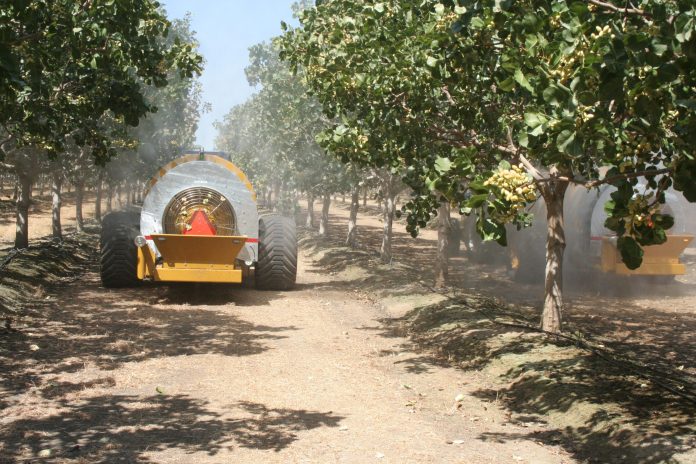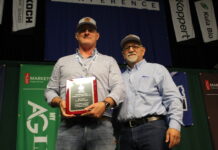
According to studies from the United Nations, the world population will increase by 1 billion people over the next decade, reaching an estimated 8.6 billion people by 2030. By 2050, Earth will have 9.8 billion inhabitants. This enormous population growth will be coupled with a corresponding increase in demand for food. Projections from the FAO have indicated that agricultural production worldwide will have to increase by an estimated 50% by 2050 to meet the needs of a growing population.
Proportionately, agricultural land is becoming scarce. Therefore, one of the biggest challenges is to improve the yield, quality and shelf life of crops by using the best fertilizers, applied in very precise doses and with proven methods. One of the best procedures to reach those goals is foliar application of nutrients in customized doses based on critical timing for each crop.
Foliar feeding is the entry of small amounts of liquid fertilizer through the surface of plant tissue. This can allow for rapid nutrient utilization by the plant. Foliar feeding provides the consultant and applicator the ability to blend the fertilizer with other products such as pesticides and micronutrients.
Current formulations of liquid fertilizers are believed to penetrate mostly the transcuticular pores on foliage, which are open virtually all the time compared to stomata. Nutrients also enter stomata, but these often are closed due to environmental stresses and darkness. Most stomata are located underneath leaves away from fertilizer spray patterns. Drawbacks to foliar feeding include the inability to apply large amounts of N, phosphorous (P) and potassium (K) without potentially burning the foliage and possibly scarring the fruit. Therefore, frequent applications of the right fertilizer and fertilizer blends at a low volume are required to maintain optimum tissue levels of key nutrients, resulting in consistent plant growth and functions like the production and transference of assimilates.
Foliar Nutrient Applications
Selecting the right fertilizers will continue to be an important part of the equation to improving yield, quality and shelf life of crops. How we apply the nutrient is also vital. Let us examine foliar spraying more closely. Crops treated with foliar spray tend to have a higher nutritional value. Improved Total Soluble Solids (TSS) have contributed to increased sugar, vitamins, minerals and proteins in the harvested crops. It is not enough just to grow more crops, but those crops must have better nutritional value for us as well.
We can see very positive effects by examining just one mineral nutrient such as K. K regulates plant functions and increases nitrogen efficiency. By increasing the saline concentration of the cells, the plants are better able to resist frosts. Applied at the right time and in the correct amount, K promotes the development of a stronger cell structure, which allows the crops to better withstand drought, disease and pests. A better internal structure promotes a prolonged shelf life. In many of our soils, we lack adequate available K to meet the crop demands. One way to meet those phenological growth stages is to supplement K sprays. This could affect the production levels and quality of numerous crops such as tuber fill and skin condition in potato, nut meat density in almond and even oil production in mint.
Originally, it was thought that using foliar nutrient applications was only appropriate when a nutritional deficiency was present. This is definitely not the case. Ongoing scientific research has consistently shown that periodic applications of certain nutrients in various crops can have a positive effect on both quantity and quality of fruits, nuts, vegetables and grain crops. Although most supplemental nutrients are absorbed through the root system, it is also important to note that leaves (and to a lesser degree stems,) flowering plant tissues and even fruit surfaces can absorb limited amounts of nutrients. It is crucial to understand which nutrients can be supplied effectively by foliar applications if the soil-supplied nutrients are inadequate or impaired in some way.
In agriculture, our scientists have identified many cases where nutrient supplementation using a foliar application may be considered more effective than an in-crop topdressing application. One such situation that has had success is during late stages of fruit development where Ca sprays applied through the season to apples has shown ability to combat Ca deficiency. This deficiency is directly connected with the physiological disorder called bitter pit. The application of Ca making direct contact with the fruit has shown good results in controlling this disorder. Also, Ca being sprayed on cherries preharvest amounted to less cracking in fruit during late maturation stages.
Research trials done in almonds have also demonstrated where a foliar-applied nutrient can have a huge impact on a crop. Knowing that fruit set is crucial in almond trees, it has been proven that micronutrients, zinc (Zn) and especially boron (B), have a significant impact on fruit set as well as on fruitlet abscission. In several fruit trees, it has been reported that even foliar spraying of one or both elements has improved productivity. In one experiment, Nonpareil trees were sprayed at full blossom with boric acid at 0.2%, Zn-50 at 0.3% and, with the combination of these micronutrients as a separate treatment, compared with a non-sprayed control. Fruit set of the B treatment was 27.7% and Zn was 22.2%. However, the B + Zn combination produced a significantly higher fruit set (38.1%) (Sotomayor et al., 2002).
Additional Benefits
As consultants, we must understand that at times only a small amount of a specific nutrient is required, and due to low soil mobility of the nutrient, it is actually more efficient to supply the small amount of needed nutrient as a foliar application. This can be the case for both macronutrients and micronutrients.
There can also be other conditions that cause a nutrient to be less available to crop roots. One example is cool, excessively wet conditions on an alkaline soil (e.g. pH >8.0) where iron is less available to certain crops (e.g. iron chlorosis of citrus trees) in heavy wet clay. Even if supplemental iron fertilizer has been applied to the soil before or at planting, it may not be available through the roots. This can also be true for numerous other crops. By monitoring the trees and observing patterns, we can offset the chlorosis in our crop with a supplemental iron foliar application. Spray applications of elements such as iron, zinc, copper and manganese may have to be repeated every three weeks when we get deficiencies of these nutrients.
Many studies include yield data collected after applying foliar sprays of various fertilizer solutions, not only to nutritionally deficient crops, but even to crops that have adequate levels of nutrients such as potassium. Crops including wheat, almonds, tomatoes, citrus, cucurbits, pome fruits and rice among many others react positively to certain nutrient sprays even when adequate soil nutrient levels are present.
A good reference to the benefits of foliar spraying is in citrus research. After years of trials addressing HLB or Huanglongbing citrus greening disease in Florida, it was determined that a foliar nutrition approach to the disease was a very viable option (www.citrusbr.com.br/download/Foliar_nutrition_forHLB.pdf). The nature of the disease restricts the ability of the plant to adequately take up nutrients though its damaged root system. Finding an alternative way to increase plant nutrition and prolong the life and productivity of the infected tree was crucial. Numerous combinations and timings were trialed.
Trials show that in the case of one nutrient combination, potassium nitrate feeding increased yields in citrus. Foliar applications with potassium nitrate have proven to be highly efficient in fulfilling the potassium requirements for many crops. The combination of potassium and nitrate in this fertilizer has been found to be beneficial in improving fruit size, dry matter, color, taste and integrity as well as resistance to biotic and abiotic stresses for citrus and tomato fruit. Moreover, the integration of potassium nitrate in routine management or in specific growth stages resulted in remarkably positive benefits to cost ratio.
Take Caution
In our management plan, caution should be used when foliar application might be more efficient but not practical. When a foliar application is relatively effective, but we cannot supply the needed nutrient in one application, multiple applications would be needed, spaced out sufficiently and timed as often as once a week. Multiple applications in field crops can be expensive due to fuel, equipment and labor costs, or where there may not be sufficient time to apply enough of the needed nutrient. We must measure the economics and limitations when determining our fertilizer plan.
In the case of a severe P deficiency, there may not be time to apply sufficient applications of low rates of foliar P to be effective. The application costs can become excessive based on the return in production. In this situation, it may be better to realize there is not much that can be done in the current season to correct the issue. Recognizing the deficiency, the preferred course of action is to apply sufficient P fertilizer to the soil prior to the planting of subsequent crops to correct the P deficiency.
If we continue to use phosphorus P as an example, we also need to understand foliar P efficiency and when it does have a fit in our fertilizer program. Foliar-applied nutrients have the benefit of being 4 to 30 times more efficient, and there is no risk of groundwater contamination. Studies using labeled P on apple, cherry, corn, tomato, potato and bean crops have shown that as much as 12 to 14% of the total P can be supplied by multiple foliar sprays. Since P can be very immobile in the soil, foliar applications can be up to 20 times more effective than soil applications.
Recognizing another nutrient use as a foliar, we can see that some foliar N sprays compared to soil applications of N include lower application rates and the ease of obtaining timely, uniform applications. With attention to best-use guidelines, the efficiency of foliar-applied N may be optimized at nearly 95 to 100%. Based on the foregoing information, if the recovery of soil-applied N can be impaired to as low as 15 to 62%, it can then be concluded by the method of estimation that foliar-applied N has an efficiency of 1.3 to 1.6 times soil-applied N at the low end and seven times at the upper end. If foliar-applied N can be up to seven times more efficient than soil-applied N, then on a pound-for-pound basis, it makes sense that we could use this information to prevent N loading to ground water. In crops such as citrus, cherries and wine grapes, we may be able to achieve 100% of the needed N by foliar application. This is not always the case, but understanding your N efficiency in your soils may prompt the need for a supplemental foliar N application. Mature, low-N-requiring crops could acquire 40 to 50 pounds N with foliar application alone. This in no way warrants replacing all of our soil applied N in all crops by using foliar.
Conclusion
In summary, it should be pointed out that we have barely scratched the surface of all the features and benefits of foliar nutrition sprays. Get to know your crop and soils as well as the correlation between total nutrients and available nutrients. Understand if your crop has shown positive response to foliar treatment even when adequate nutrient levels are in the soil. Ask yourself: when do soil conditions prevent adequate nutrient uptake? What conditions should I be aware of to optimize foliar applications (rain, temperature, wind, sprayer capability, pH of my solution, humidity, physiological growth stage, activity of plant parts like stomate, additives such as pesticides or adjuvants and antagonist as well as synergistic reactions with other nutrients.) Study absorption rates and what affects them. Like all other things in agriculture, foliar nutrition is a tool.
References
Sotomayor, C., Silva, H. and Castro, J. (2002). Effectiveness of boron and zinc foliar sprays on fruit setting of two almond cultivars. Acta Hortic. 591, 437-440, https://doi.org/10.17660/ActaHortic.2002.591.67.


















